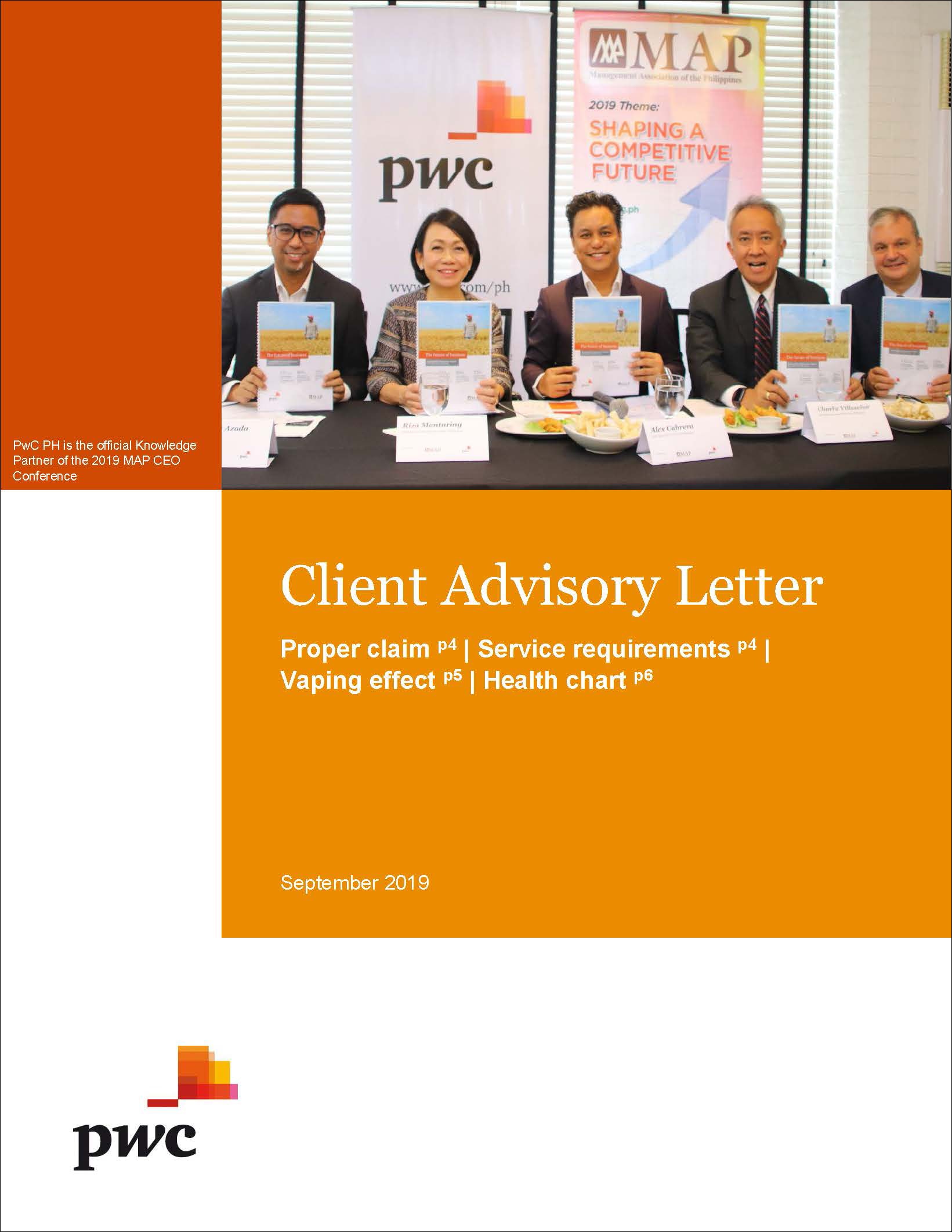

This is a publication about developments in Philippine taxation. The contents usually include latest Republic Acts, Bureau of Internal Revenue issuances, Customs regulations, Court decisions, BSP circulars, SEC circulars, Department of Justice opinions and Executive Orders relevant to Tax practice.
Talk to us
For further discussion on the contents of this issue of the Client Advisory Letter, please contact any of our partners.
Request for copies of text
You may ask for the full text of the Client Advisory Letter by writing our Tax Department, Isla Lipana & Co., 29th Floor, Philamlife Tower, 8767 Paseo de Roxas, 1226 Makati City, Philippines. T: +63 (2) 8845 2728. F: +63 (2) 8845 2806.

How AI will transform the CFO’s role
With smarter automation taking over rote tasks and AI improving analytics, finance leaders can become powerful strategic advisers
Perhaps no business function — or C-suite role — offers such fertile ground for automation and AI to help spur growth as finance.
CFOs are uniquely positioned to lead a broader organizational shift into digitization. They have insight into all business units and can help leaders from every area of the organization understand the why of finance data, not just the what — ultimately leading to smarter business decisions throughout the enterprise. Here’s how CFOs can lead this change – CFOs should be looking at the possibilities. There are five key steps to help you that we’ve outlined in this report.
- Set targets for outcomes and benefits
What’s most important to your organization? Efficiency, effectiveness, expansion or disruption?
Robotic process automation (RPA) can help increase both efficiency and effectiveness.
To expand into new markets, disrupt an industry or tackle complex problems, you’ll need to employ more advanced tools, like AI and machine learning. - Directly involve frontline employees
Automation and analytics can seem like a disruptive threat to many employees.
CFOs can overcome resistance and generate buy-in by giving people the right training, tools, autonomy, incentives and appropriate governance structures.
This may include giving the finance workforce a hands-on role in developing and deploying a digital tool kit that ultimately automates and streamlines processes, freeing employees for higher-value work.
Look for ways to bring finance experts together with data scientists to marry specialized expertise with technical ability. - Define your area of focus across people, processes and performance
How you integrate automation and AI should fit into a broader finance transformation strategy.
The goal is to strike the ideal balance — unique to your organisation — across people (upskilling employees and improving the value proposition of the finance function), processes (making that function more effective) and performance (generating bottom-line financial results for the company).
In PwC's 22nd Annual Global CEO Survey, 55% reported that a lack of key skills is inhibiting their ability to innovate. - Put a governance structure in place, both for data and for AI overall
Create a governance structure that lets finance pull data from the right sources, ensure that it is accurate and clean, and give access to the right people at the right time.
Help business leaders integrate insights from data by providing them with ways to visualise it and create side-by-side comparisons.
Provide structures for governance of AI models to help ensure end-to-end AI governance, from the definition of your AI strategy, through training, testing, deploying and monitoring AI and the data used to train it. - Prepare the workforce
Frontline employees need structured training and upskilling programmes to be able to contribute high-value work in a finance function where more tasks and processes are automated.
In addition to training and upskilling, you may need to spearhead cultural change, helping traditionally risk-averse finance employees see that, in some areas, trying new things with AI — with the proper controls in place — could create value in the long run.
For an e-copy of the report, contact us at markets@ph.pwc.com
Taxes, compliance matters, assessments, and refunds
Proper claim
Refund of erroneously paid taxes
Dividends paid by a domestic corporation to a Dutch stockholder were subjected to the 10% final withholding tax (FWT) pursuant to the Philippines-Netherlands tax treaty. However, the related tax treaty relief application was denied by the BIR and the DOF for being filed after the dividend payment.
As a consequence, the domestic corporation remitted to the BIR a 5% FWT representing the difference between the 15% FWT rate imposed by the Tax Code and the 10% FWT tax treaty rate used. Subsequently, a claim for refund of excess and erroneous payment of said 5% FWT was filed.
According to the CTA, the payment of the 5% FWT is a proper subject of a refund claim because, for purposes of claiming refunds, erroneous tax payments pertain not only to taxes paid based on mistake of fact but also include payments of taxes that are not legally due.
(CTA EB No. 2008, promulgated 2 September 2019)
Proof of payment
When an assessment for final withholding value-added tax is proper
The final withholding value-added tax (FW-VAT) on payments to non-residents for use of their property rights, or for services rendered in the Philippines should be withheld at the time of payment. Accordingly, in assessing the taxpayer for deficiency FW-VAT, the BIR should be able to prove the fact of payment during the taxable year concerned. Otherwise, the deficiency FW-VAT assessment shall be cancelled.
(CTA Case No. 9483, promulgated 2 September 2019)
Failed cure
Service of assessment notices and FDDA to authorized representatives
The failure of the BIR to prove actual receipt of the Letter of Authority, Preliminary Assessment Notice, Final Assessment Notice (FAN) and Final Decision on Disputed Assessment (FDDA) by authorized representatives of the taxpayer renders the assessment void for violating the taxpayer’s right to due process. The fact that the taxpayer was able to protest the FAN does not cure the violation.
(CTA Case No. 8740, promulgated 2 September 2019)
Service requirements
Properly effecting the personal service of the FAN and FLD
Personal service of the FAN and Formal Letter of Demand (FLD) should be made to the taxpayer himself or his duly authorized representative who shall acknowledge receipt by stating his/her name, designation and authority to receive the same, signing, and indicating the date of receipt.
(CTA Case Nos. 9490 & 9503, promulgated 24 September 2019)
Continuing exemption
Tax exemption of foreign currency deposits
Under RA No. 6426, all foreign currency deposits, including interest and all other income or earnings of such deposits, are exempt from all taxes as long as such deposits are eligible or allowed.
The above law remains the governing law on the tax exemption of foreign currency deposits because:
- The tax exemption was not revoked by the Tax Code; and
- RA No. 6426 prevails over the Tax Code because the former is a special law which governs the foreign currency deposit system while the latter is a general law on national internal revenue taxes.
(CTA Case No. 9626, promulgated 2 September 2019)
Earmarking contract
When a contract may be deemed a regulation
A taxpayer protested deficiency local business tax assessments because the subject revenues were earmarked for remittance to the Philippine Ports Authority (PPA), hence, did not form part of taxable gross receipts.
According to the CTA, in order for an amount to be considered as earmarked and not forming part of taxable gross receipts, the following must be established:
- The amount must have been designated for a specific purpose;
- The amount must be identifiable and distinguishable from other property of the same nature; and
- There must be a law or regulation reserving the amount for some other person.
Citing a Supreme Court decision, the CTA held that the term “regulation” in the third requisite includes a contract which provides that another person is entitled to receive a certain percentage of gross income. After reviewing the contract between the taxpayer and the PPA, the CTA held that the PPA fees may be considered earmarked amounts.
(CTA AC No. 199, promulgated 25 September 2019)
Vaping effect
Excise taxes on tobacco products, and heated tobacco and vapor products
The BIR disseminated RA No. 11346 which increases the excise tax on tobacco products and imposes excise taxes on heated tobacco and vapor products. It also earmarks excise taxes on sugar-sweetened beverages, alcohol products, tobacco products, and heated tobacco and vapor products to the Philippine Health Insurance Corporation for the implementation of the Universal Health Care Act of 2019.
RA No. 11346 takes effect on 1 January 2020.
(Revenue Memorandum Circular No. 92-2019, issued 5 September 2019)
Quality audit
Issuance of transfer pricing audit guidelines
The BIR issued Transfer Pricing (TP) Audit Guidelines to supplement RAMO No. 1-2000 and RAMO No. 1-2008, and to provide standardized audit procedures and techniques in the audit of taxpayers with related party and/or intra-firm transactions.
The TP Audit Guidelines apply to controlled transactions including the sale, purchase, transfer and utilization of tangible and intangible assets, provision of intra-group services, interest payments and capitalization between related/associated parties, where at least one party is assessable or chargeable to tax in the Philippines.
They are also applicable, by analogy, to transactions between a permanent establishment and its head office or branches.
(Revenue Audit Memorandum Order No. 1-2019, dated 20 August 2019)

















